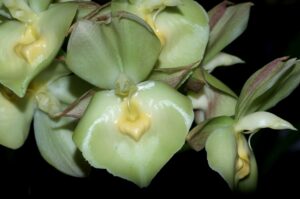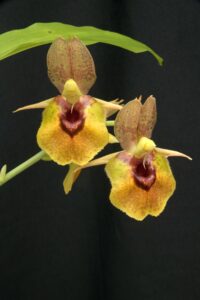The following article was written for the Orchid Species Bulletin published by the Orchid Species Society, which is based in Brisbane, Queensland in April 2004, and updated in February 2024.
Bear in mind that any cultivation notes refer to the subtropical conditions of Southern Queensland, Australia.

Catasetum expansum Male flowers
Catasetum expansum was described by Heinrich Gustav Reichenbach as Ctsm. expansum in Otia Botanica Hamburgensia in 1878. The specific epithet comes from the Latin expansus (expanded, spread out), referring to the broad lip of the male flowers.
Ctsm. expansum is a sympodial, epiphytic plant, which produces clustered, slightly compressed, conical to spindle-shaped pseudobulbs that are 15-25 cm long and 3-5 cm broad. When new, the pseudobulbs are covered by leaf sheaths that soon become papery white, with age. The 4-10 leaf sheaths on each pseudobulb bear linear-lanceolate leaves that are 30-48 cm long, and 4-7.5 cm broad. Bearing 3 prominent veins, the leaves are soon deciduous.

Catasetum expansum Plant about to bloom
Arched to pendulous inflorescences, which bear male flowers are produced from the base of the recently matured pseudobulbs. The male-flowered racemes of Ctsm. expansum are up to 30 cm long, and bear 5-15 showy, resupinate flowers that are 6-9 cm across. Large, mature plants often produce successive racemes from late spring, summer and into autumn.
Variable in lip form, and flower colour, the male flowers of Ctsm. expansum are recognised by the broad, flattened lip, with a large fleshy callus next to the basal cavity. Pale green, to pale yellow, and sometimes golden yellow, or white, the sepals and petals of the male flowers may have some or a few wine-red spots on those segments. The darker green, to pale yellow lip has a cream, to yellow, or orange triangular callus in front of the lip opening, and may be covered with wine red. The wine-red spotting may extend over the lip, around the opening. Its column is very light green, and the antennae are white. The cultivar ‘Gold Pucker’ has green flowers, which have a golden-yellow callus. Short-lived, the male flowers produce a faint, daytime, medicinal scent, similar to menthol, naphthalene or turpentine, which is strongest in the morning. They last for 5-7 days.

Catasetum expansum ‘Speckled Spectacle’
Inflorescences on Ctsm. expansum bearing female flowers are shorter and erect, carrying fewer (3-5), non-resupinate, helmet-shaped flowers, which are green. In nature, pollination of the female flower is by male Euglossine bees.
Endemic to western Ecuador, Ctsm. expansum grows in dry forest, from near sea level to 700 m altitude. Ctsm. expansum requires light to moderate shade, such as about 70% shading in the southeast Queensland region. Dormant, leafless pseudobulbs should be kept dry during winter, and repotted into new media as new growth commences. Cultivate it in a well-drained medium, and gradually increase watering once new roots commence. Expert cultivator and Catasetum hybridiser, Fred Clarke recommends that watering not be commenced until the new roots are at least 7.5 cm long. That ensures a good-sized root system supports the new growth, otherwise the onset of significant moisture curtails the new roots developing.
When growth is well-underway, water Ctsm. expansum often, to keep the medium moist, and ensure good air circulation, with high humidity, while it is actively growing. Plants will respond to regular applications of liquid fertiliser, while in growth. Alternatively a small amount of slow-release fertiliser can be supplied, at the beginning of the growing season. Cease fertilising, once the pseudobulb matures, and reduce watering when the leaves begin to yellow, and drop.
References:
Bechtel, H., Cribb, P. & E. Launert. (1992) The Manual of Cultivated Orchid Species. 3rd ed. Blandford Press, London.
Dodson, C.H. & P.M. Dodson. (1980) Icones Plantarum Tropicarum, Series I – Fasc.1: Ecuador. The Marie Selby Botanical Gardens, Sarasota, Florida.
Holst, A.W. (1999) The World of Catasetums. Timber Press, Portland, Oregon.
Stearn, W.T. (1983) Botanical Latin. 3rd ed. David & Charles Inc. Vermont, USA.
Stewart, J. & M. Griffiths. (1995) Manual of Orchids. Timber Press, Portland, Oregon.
